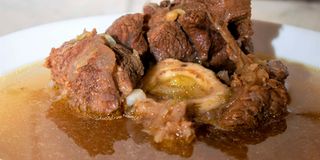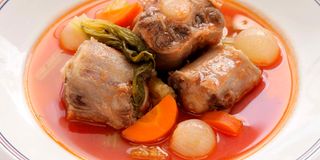
Natural clear beef soup.
In the evening hours in Nairobi's estates, you will find people queuing outside butcheries. At first, you would wonder why meat has become a crowd-puller until you see bone soup being served in metal cups.
The soup is served hot, and as the people wait for it to cool down, they are busy eating mutura (a kind of African sausage made from the intestines of goats or cows).
In Nairobi's Kasarani estate, for instance, Shadrack Kiptum, who runs a butchery, says that in the evenings, his business comes alive. Outside his butchery, there is always a large pan with cow hooves boiling.
“Every evening I need to ensure that I have four employees. Two will be inside serving the customers while two will be outside serving soup and mutura. I sell a cup of soup at Sh20," he says.

Butcher Francis Makonyo (C) makes goat soup at Club Charina in Umoja One off Kang'undo Road, Moi Drive, on December 31, 2022 ahead of New Year celebrations.
On the other side of the city, along Kikuyu Road, we meet Paul Mburu. The 50-year-old has been running Blessed Butchery for 10 years now. A normal day for Mr Mburu starts at 6am when he starts boiling the soup in a 40-litre capacity pan.
“By 6am, the soup needs to be on the jiko for it to be ready by 3pm. It must boil for hours, then I put it in five-litre bottles and skim it by shuffling it continuously for some time. This is to remove the excess fat from the soup. Some customers don’t like seeing the layer of fat floating in their cup of soup,” he says.
For years, bone broth was considered a health booster for older people who needed to strengthen their bones. However, it now become a common delicacy among young people, especially gym-goers and those seeking to lose weight.
“Over the years, I have noted an increase in young people coming to buy my soup, more women than men,” Mr Mburu says.
The queues are replicated at City Market in Nairobi’s Central Business District, as Kenyans seek to buy cow bones costing Sh150 per kilo.
“Right now, I have no bones to sell. People are always asking for them. I have a client from Kilimani who has just called asking me to deliver five kilos of bones. He keeps some for himself and sends others to his family in Machakos,” says Benjamin Kimani, who runs a butchery inside the market.
Besides the bones, he also sells bone marrow at Sh750 per kg, which is also in high demand.
Camel bones
Esther Nyambura, a mother of four, is among the lovers of bone broth and makes it from camel bones. She buys the camel bones at Sh300 per kg.
"I struggled with back pains after childbirth. It would get so bad that I had to rely on painkillers. My mother recommended that I drink bone broth to strengthen my bones. I started taking it every day. Now it has become a family delicacy. I just add spices like coriander to make it sweeter. I believe that it helps boost our immunity,” the 51-year-old said.
As bone broth gains a cult following, is it just a craze? Nutritionists say that bone broth has significant health benefits.
Maryanne Wanza, a registered nutritionist and dietitian, says: “Bone broth is high in collagen, which is a protein that helps build bones. It also contains gelatin, a dissolved version of collagen, which is beneficial for connective tissues, skin elasticity and even digestive health. Bone broth also contains omega-3 fatty acids, which are beneficial for brain health. 60 percent of your brain is actually fat, and getting that good quality omega-3 fatty acids from bone broth would be healthy.”
She adds that the quality of bone broth depends on the type of bones used. “Bones that contain marrow, like those from cows and goats, are more nutrient-dense. They contain omega-3 fatty acids.”
Sarah Mkochi, who runs Bitewise Nutrition, says that bone broth provides essential amino acids that the body cannot produce on its own: The muscle meat we consume gives us part of the amino acids, but the broth provides the remaining amino acids, making it a complete protein source.”
Bone broth is a run-to for many people looking to lose weight and are doing intermittent fasting. Many say that a cup of bone broth is what they take immediately when they break their fast.
Ms Wanza says that no single food directly causes weight loss. “It all depends on total calorie consumption. If bone broth is high in fat and you exceed your daily calorie needs, it could contribute to weight gain rather than weight loss.”
Ms Mkochi says that many people use bone broth as a meal replacement. “If someone drinks bone broth instead of eating solid meals, they may feel full and consume fewer calories overall. The risk is that once they return to their regular diet, the weight might come back. It’s not a sustainable solution,” she warns.
Health risks
Despite its numerous benefits, excessive consumption of bone broth can pose health risks. “Bone broth contains fat, which, if consumed in large amounts, could contribute to cardiovascular issues.
“Suppose your bone broth has a higher fat content. In that case, you’re increasing the risk of more fat deposits to your blood cells, which can cause atherosclerosis (where cholesterol builds up in the artery walls), causing the thinning and hardening of your blood vessels,” Ms Wanza says.
She adds that the other health risk comes in when you use too much salt in your bone broth. “If your bone broth becomes too salty, then it becomes a medium of consuming way more salt than your body would need.”
Ms Mkochi cautions against the heavy metals found in bone broth. “Some studies have found high levels of lead in bone broth, especially from animals raised in industrial settings. This could be harmful to the brain and overall health. The best way to minimize this risk is by using free-range, naturally raised animals,” she says.

Preparing bone broth
Many people prefer to buy animal bones and prepare the bone broth for themselves. Ms Mkochi advises that the method of preparation determines the nutritional value of bone broth.
“To extract the full benefits, bones should be boiled for at least 12 to 48 hours. A short boiling time won’t release all the beneficial nutrients like glycine and collagen.”
Ms Wanza recommends adding vegetables to the bone broth to enhance the nutrient profile. “Throw in some carrots, tomatoes, onions, or even spinach towards the end of cooking. This adds fiber and extra vitamins. Skimming off excess fat also makes it healthier.”
Is it better to make bone broth at home or buy it from a restaurant? “If you make it yourself, you control what goes into it. You can choose high-quality bones, avoid excess fat and salt, and customise the flavour, Ms Wanza says. “Restaurant-prepared bone broth is fine, but always ask about its preparation. If you don’t know what’s in it, you lose control over its quality,” she continues.
Who should take bone broth?
“Bone broth is suitable for all demographics, but it may be particularly beneficial for children, pregnant women and the elderly.
“For children, it introduces essential nutrients in an easily digestible form. Pregnant and breastfeeding women benefit from the hydration and collagen support. The elderly, who may struggle with bone health, can use it to support joint and skeletal health,” Ms Wanza says.
Bone broth is also commonly used in hospitals.
“Patients recovering from surgery often start with clear liquid soups, which include bone broth, as their first meal post-operation,” Ms Wanza says.












